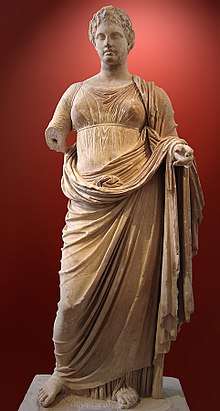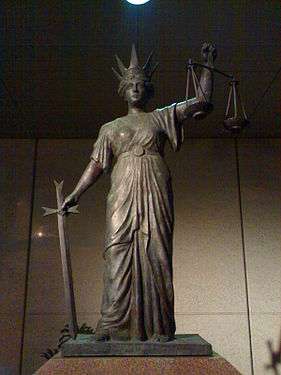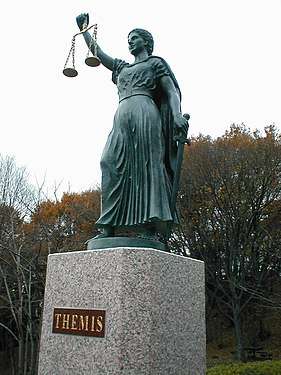Themis
Themis (/ˈθiːmɪs/; Ancient Greek: Θέμις) is an ancient Greek Titaness. She is described as "[the Lady] of good counsel", and is the personification of divine order, fairness, law, natural law, and custom. Her symbols are the Scales of Justice, tools used to remain balanced and pragmatic. Themis means "divine law" rather than human ordinance, literally "that which is put in place", from the Greek verb títhēmi (τίθημι), meaning "to put".
| Themis | |
|---|---|
Titaness of divine law and order | |
| Member of the Titans | |
 Themis of Rhamnous, Attica, by the sculptor Chairestratos, c. 300 BCE | |
| Abode | Mount Olympus |
| Symbol | Bronze Sword |
| Personal information | |
| Parents | Uranus and Gaia |
| Siblings |
|
| Consort | Zeus |
| Offspring | |
To the ancient Greeks she was originally the organizer of the "communal affairs of humans, particularly assemblies".[1] Moses Finley remarked of themis, as the word was used by Homer in the 8th century BCE, to evoke the social order of the 10th- and 9th-century Greek Dark Ages:
Themis is untranslatable. A gift of the gods and a mark of civilized existence, sometimes it means right custom, proper procedure, social order, and sometimes merely the will of the gods (as revealed by an omen, for example) with little of the idea of right.[2]
Finley adds, "There was themis—custom, tradition, folk-ways, mores, whatever we may call it, the enormous power of 'it is (or is not) done'. The world of Odysseus had a highly developed sense of what was fitting and proper."[3]
Mythology

The personification of abstract concepts is characteristic of the Greeks. The ability of the goddess Themis to foresee the future enabled her to become one of the Oracles of Delphi, which in turn led to her establishment as the goddess of divine justice.
Some classical representations of Themis showed her holding a sword, believed to represent her ability to cut fact from fiction; to her there was no middle ground (depictions of Lady Justice wearing a blindfold are modern and not classical). Themis built the Oracle at Delphi and was herself oracular. According to another legend, Themis received the Oracle at Delphi from Gaia and later gave it to Phoebe.[4]
When Themis is disregarded, Nemesis brings just and wrathful retribution; thus Themis shared the Nemesion temple at Rhamnous. Themis is not wrathful: she, "of the lovely cheeks", was the first to offer Hera a cup when she returned to Olympus distraught over threats from Zeus.[5]
Themis presided over the proper relation between man and woman, the basis of the rightly ordered family (the family was seen as the pillar of the deme), and judges were often referred to as "themistopóloi" (the servants of Themis). Such was also the basis for order upon Olympus. Even Hera addressed her as "Lady Themis". The name of Themis might be substituted for Adrasteia in telling of the birth of Zeus on Crete.
Themis was present at Delos to witness the birth of Apollo. According to Ovid, it was Themis rather than Zeus who told Deucalion to throw the bones of "his Mother" over his shoulder to create a new race of humankind after the deluge.
Hesiod's description and contrast to Dike
Themis occurred in Hesiod's Theogony as the first recorded appearance of Justice as a divine personage. Drawing not only on the socio-religious consciousness of his time but also on many of the earlier cult-religions, Hesiod described the forces of the universe as cosmic divinities. Hesiod portrayed temporal justice, Dike, as the daughter of Zeus and Themis.
Dike executed the law of judgments and sentencing and, together with her mother Themis, she carried out the final decisions of Moirai. For Hesiod, Justice is at the center of religious and moral life who, independently of Zeus, is the embodiment of divine will. This personification of Dike stands in contrast to justice viewed as custom or law and as retribution or sentence.[6]
Aeschylean description
In the play Prometheus Bound, traditionally attributed to Aeschylus, Themis is the mother of Prometheus, and gave him foreknowledge of what was to come.[7] It is said by Prometheus that she is called many names, including Gaéa.[7]

Family
In Greek mythology, Hesiod mentions[8] Themis among the six sons and six daughters of Gaia and Uranus (Earth and Sky). Among these Titans of primordial myth, few were venerated at specific sanctuaries in classical times.
The only consort for Themis mentioned in the sources below is Zeus. One of her few children was called Natura, the Greek goddess of the forest.
Horae: the Hours
With Zeus she more certainly bore the Horae,[9] those embodiments of the right moment, the rightness of order unfolding in time.
First generation:
- Auxo (the grower)
- Carpo (the fruit-bringer)
- Thallo (the plant-raiser)
Second generation:
- Dike (justice)
- Eirene (peace)
- Eunomia (order of law)
Moirai: the Fates
Followers of Zeus claimed that it was with him that Themis produced the Moirai, three Fates.[10] A fragment of Pindar,[11] however, tells that the Moirai were already present at the nuptials of Zeus and Themis; that in fact the Moirai rose with Themis from the springs of Okeanos the encircling world-ocean and accompanied her up the bright sun-path to meet Zeus at Mount Olympus. To compliment Pindar, Hesiod also tells us in the Theogony that the Moirai were born from Nyx who lay with no one.[12]
Cult
Themis had several temples in Greece, though they are not described in any great detail by ancient authors. She had temples at the oracular shrine of Zeus at Dodona, at Tanagra,[13] in Athens,[14] and a Temple of Themis Ikhnaia in Phthiotis, Thessalia.[15] Pausanias describe her sanctuary in Thebes in somewhat more detail than what was normally the case and it may therefore have been of more importance:
- "Along the road from the Neistan gate [at Thebes, Boiotia] are three sanctuaries. There is a sanctuary of Themis, with an image of white marble; adjoining it is a sanctuary of the Moirai (Moirae, Fates) [her daughters], while the third is of Zeus Agoraios (of the Market)."[16]
Themis also had an altar in Olympia: "On what is called the Stomion (Mouth) the altar to Themis has been built."[17] Themis was sometimes depicted in the sanctuaries of other gods and may have shared temples with them occasionally, and she is mentioned to have shared a temple with Aphrodite in Epidauros: "Within the grove [of the sanctuary of Asklepios (Asclepius) at Epidauros] are a temple of Artemis, an image of Epione, a sanctuary of Aphrodite and Themis, a race-course."[18]
Genealogy
| Themis' family tree [19] | |||||||||||||||||||||||||||||||||||||||||||||||||||||||||||||||||||||||||||||||||||||||||||||||||||||||||||||||||||||||||||||||||||||||||||||||||||||||||||||||||||||||||||||||||||||||||||||||||||||||||||||||||||||||||||||||||||||||||||||||||||||||||||||||||||||||||||||||||||||||||||||||||||||||||||||||||||||||||||||||||||||||||||||||||||||||||||||||||||||||||||||||||||||||||||||||||||||||||||||||||||||||||||||||||||||||||||||||||||||||||||||||||||||||||||||||||||||||||||||||||||||||||||||||||||||||||||||||||||||||||||||||||||||||||||||||||||||||||||||||||||||||||||||||||||||||||||||||||||||||||||||||||||||||||||||||||||||||||||||||||||||||||||||||||||||||||||||||||||||||||||||||||||||||||||||||||||||||||||||||||||||||||||||||||||||||||||||||||||||||||||||||||||||||||||||||||||||||||||||||||||||||||||||||||||||||||||||||||||||||||||||||||||||||||||||||||||||||||||||||||||||||||||||||||||||||||||||||||||||||||||||||||||||||||||||||||||||||||||||||||||||||||||||||||||||||||||||||||||||||
|---|---|---|---|---|---|---|---|---|---|---|---|---|---|---|---|---|---|---|---|---|---|---|---|---|---|---|---|---|---|---|---|---|---|---|---|---|---|---|---|---|---|---|---|---|---|---|---|---|---|---|---|---|---|---|---|---|---|---|---|---|---|---|---|---|---|---|---|---|---|---|---|---|---|---|---|---|---|---|---|---|---|---|---|---|---|---|---|---|---|---|---|---|---|---|---|---|---|---|---|---|---|---|---|---|---|---|---|---|---|---|---|---|---|---|---|---|---|---|---|---|---|---|---|---|---|---|---|---|---|---|---|---|---|---|---|---|---|---|---|---|---|---|---|---|---|---|---|---|---|---|---|---|---|---|---|---|---|---|---|---|---|---|---|---|---|---|---|---|---|---|---|---|---|---|---|---|---|---|---|---|---|---|---|---|---|---|---|---|---|---|---|---|---|---|---|---|---|---|---|---|---|---|---|---|---|---|---|---|---|---|---|---|---|---|---|---|---|---|---|---|---|---|---|---|---|---|---|---|---|---|---|---|---|---|---|---|---|---|---|---|---|---|---|---|---|---|---|---|---|---|---|---|---|---|---|---|---|---|---|---|---|---|---|---|---|---|---|---|---|---|---|---|---|---|---|---|---|---|---|---|---|---|---|---|---|---|---|---|---|---|---|---|---|---|---|---|---|---|---|---|---|---|---|---|---|---|---|---|---|---|---|---|---|---|---|---|---|---|---|---|---|---|---|---|---|---|---|---|---|---|---|---|---|---|---|---|---|---|---|---|---|---|---|---|---|---|---|---|---|---|---|---|---|---|---|---|---|---|---|---|---|---|---|---|---|---|---|---|---|---|---|---|---|---|---|---|---|---|---|---|---|---|---|---|---|---|---|---|---|---|---|---|---|---|---|---|---|---|---|---|---|---|---|---|---|---|---|---|---|---|---|---|---|---|---|---|---|---|---|---|---|---|---|---|---|---|---|---|---|---|---|---|---|---|---|---|---|---|---|---|---|---|---|---|---|---|---|---|---|---|---|---|---|---|---|---|---|---|---|---|---|---|---|---|---|---|---|---|---|---|---|---|---|---|---|---|---|---|---|---|---|---|---|---|---|---|---|---|---|---|---|---|---|---|---|---|---|---|---|---|---|---|---|---|---|---|---|---|---|---|---|---|---|---|---|---|---|---|---|---|---|---|---|---|---|---|---|---|---|---|---|---|---|---|---|---|---|---|---|---|---|---|---|---|---|---|---|---|---|---|---|---|---|---|---|---|---|---|---|---|---|---|---|---|---|---|---|---|---|---|---|---|---|---|---|---|---|---|---|---|---|---|---|---|---|---|---|---|---|---|---|---|---|---|---|---|---|---|---|---|---|---|---|---|---|---|---|---|---|---|---|---|---|---|---|---|---|---|---|---|---|---|---|---|---|---|---|---|---|---|---|---|---|---|---|---|---|---|---|---|---|---|---|---|---|---|---|---|---|---|---|---|---|---|---|---|---|---|---|---|---|---|---|---|---|---|---|---|---|---|---|---|---|---|---|---|---|---|---|---|---|---|---|---|---|---|---|---|---|---|---|---|---|---|---|---|---|---|---|---|---|---|---|---|---|---|---|---|---|---|---|---|---|---|---|---|---|---|---|---|---|---|---|---|---|---|---|---|---|---|---|---|---|---|---|---|---|---|---|---|---|---|---|---|---|---|---|---|---|---|---|---|---|---|---|---|---|---|---|---|---|---|---|---|---|---|---|---|---|---|---|---|---|---|---|---|---|---|---|---|---|---|---|---|---|---|---|---|---|---|---|---|---|---|---|---|---|---|---|---|---|---|---|---|---|---|---|---|---|---|---|---|---|---|---|---|---|---|---|---|---|---|---|---|---|---|---|---|---|---|---|---|---|---|---|---|---|---|---|---|---|---|---|---|---|---|---|---|---|---|---|---|---|---|---|---|---|---|---|---|---|---|---|---|---|---|---|---|---|---|---|---|---|---|---|---|---|---|---|---|---|---|---|---|---|---|---|---|---|---|---|---|---|---|---|---|---|---|---|---|---|---|---|---|---|---|---|---|---|---|---|---|---|---|---|---|---|---|---|---|---|---|---|---|---|---|---|---|---|---|---|---|---|---|---|---|---|---|---|---|---|---|---|---|---|---|---|---|---|---|---|---|---|---|---|---|---|---|---|---|---|---|---|---|---|---|---|---|---|---|---|---|---|---|---|---|---|---|---|---|---|---|---|---|---|---|---|---|---|---|---|---|---|---|---|---|---|---|---|
| |||||||||||||||||||||||||||||||||||||||||||||||||||||||||||||||||||||||||||||||||||||||||||||||||||||||||||||||||||||||||||||||||||||||||||||||||||||||||||||||||||||||||||||||||||||||||||||||||||||||||||||||||||||||||||||||||||||||||||||||||||||||||||||||||||||||||||||||||||||||||||||||||||||||||||||||||||||||||||||||||||||||||||||||||||||||||||||||||||||||||||||||||||||||||||||||||||||||||||||||||||||||||||||||||||||||||||||||||||||||||||||||||||||||||||||||||||||||||||||||||||||||||||||||||||||||||||||||||||||||||||||||||||||||||||||||||||||||||||||||||||||||||||||||||||||||||||||||||||||||||||||||||||||||||||||||||||||||||||||||||||||||||||||||||||||||||||||||||||||||||||||||||||||||||||||||||||||||||||||||||||||||||||||||||||||||||||||||||||||||||||||||||||||||||||||||||||||||||||||||||||||||||||||||||||||||||||||||||||||||||||||||||||||||||||||||||||||||||||||||||||||||||||||||||||||||||||||||||||||||||||||||||||||||||||||||||||||||||||||||||||||||||||||||||||||||||||||||||||||||
Notes
- (University of Washington School of Law) Themis, Goddess of Justice
- Finley, The World of Odysseus, rev. ed.(New York: Viking Prewss) 1978: 78, note.
- Finley, The World of Odysseus. p. 82.
- Aeschylus, Eumenides 1 ff.
- Iliad xv. 88
- Donna Marie Giancola, "Justice and the Face of the Great Mother (East and West)"
- Aeschylus, Prometheus Bound, lines 217–219.
- Hesiod. Theogony, 132; this origin was part of Orphic tradition as well (Orphic Hymn 79).
- Hesiod. Theogony, 901 ff.
- Hesiod. Theogony, 904
- Pindar, fragment 30.
- Hesiod. Theogony,
- Pausanias. Description of Greece, 9.22.1
- Pausanias. Description of Greece, 1.22.1
- Strabo, Geography 3. 2. 11 (trans. Jones)
- Pausanias. Description of Greece, 9.25.4
- Pausanias. Description of Greece, 5.14.10
- Pausanias. Description of Greece, 2.27.6
- Hesiod, Theogony 132–138, 337–411, 453–520, 901–906, 915–920; Caldwell, pp. 8–11, tables 11–14.
- Although usually the daughter of Hyperion and Theia, as in Hesiod, Theogony 371–374, in the Homeric Hymn to Hermes (4), 99–100, Selene is instead made the daughter of Pallas the son of Megamedes.
- According to Hesiod, Theogony 507–511, Clymene, one of the Oceanids, the daughters of Oceanus and Tethys, at Hesiod, Theogony 351, was the mother by Iapetus of Atlas, Menoetius, Prometheus, and Epimetheus, while according to Apollodorus, 1.2.3, another Oceanid, Asia was their mother by Iapetus.
- According to Plato, Critias, 113d–114a, Atlas was the son of Poseidon and the mortal Cleito.
- In Aeschylus, Prometheus Bound 18, 211, 873 (Sommerstein, pp. 444, 445 n. 2, 446, 447 n. 24, 538, 539 n. 113) Prometheus is made to be the son of Themis.
References
- Anonymous, The Homeric Hymns and Homerica with an English Translation by Hugh G. Evelyn-White. Homeric Hymns. Cambridge, MA.,Harvard University Press; London, William Heinemann Ltd. 1914. Online version at the Perseus Digital Library.
- Apollonius Rhodius, Argonautica translated by Robert Cooper Seaton (1853–1915), R. C. Loeb Classical Library Volume 001. London, William Heinemann Ltd, 1912. Online version at the Topos Text Project.
- Apollodorus, Apollodorus, The Library, with an English Translation by Sir James George Frazer, F.B.A., F.R.S. in 2 Volumes. Cambridge, Massachusetts, Harvard University Press; London, William Heinemann Ltd. 1921. Online version at the Perseus Digital Library.
- Clement of Alexandria, Recognitions from Ante-Nicene Library Volume 8, translated by Smith, Rev. Thomas. T. & T. Clark, Edinburgh. 1867. Online version at theio.com
- Diodorus Siculus, Diodorus Siculus: The Library of History. Translated by Charles Henry Oldfather. Twelve volumes. Loeb Classical Library. Cambridge, Massachusetts: Harvard University Press; London: William Heinemann, Ltd. 1989.Online version at the Lacus Curtius: Into the Roman World.
- Hesiod, The Homeric Hymns and Homerica with an English Translation by Hugh G. Evelyn-White, Cambridge, MA.,Harvard University Press; London, William Heinemann Ltd. 1914. Online version at the Perseus Digital Library.
- Homer, The Iliad with an English Translation by A.T. Murray, Ph.D. in two volumes. Cambridge, MA., Harvard University Press; London, William Heinemann, Ltd. 1924. Online version at the Perseus Digital Library.
- Hyginus, Fabulae from The Myths of Hyginus translated and edited by Mary Grant. University of Kansas Publications in Humanistic Studies. Online version at the Topos Text Project.
- Hyginus, Astronomica from The Myths of Hyginus translated and edited by Mary Grant. University of Kansas Publications in Humanistic Studies. Online version at the Topos Text Project.
- Antoninus Liberalis, The Metamorphoses of Antoninus Liberalis translated by Francis Celoria (Routledge 1992). Online version at the Topos Text Project.
- Nonnus, Dionysiaca translated by William Henry Denham Rouse (1863–1950), from the Loeb Classical Library, Cambridge, MA, Harvard University Press, 1940. Online version at the Topos Text Project.
- Ovid, Metamorphoses translated by Brookes More (1859–1942). Boston, Cornhill Publishing Co. 1922. Online version at the Topos Text Project.